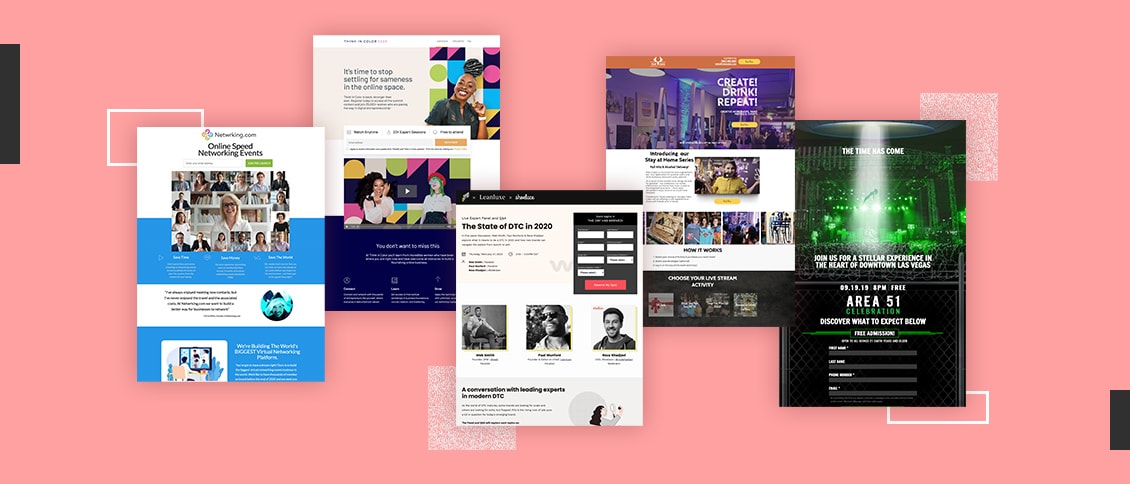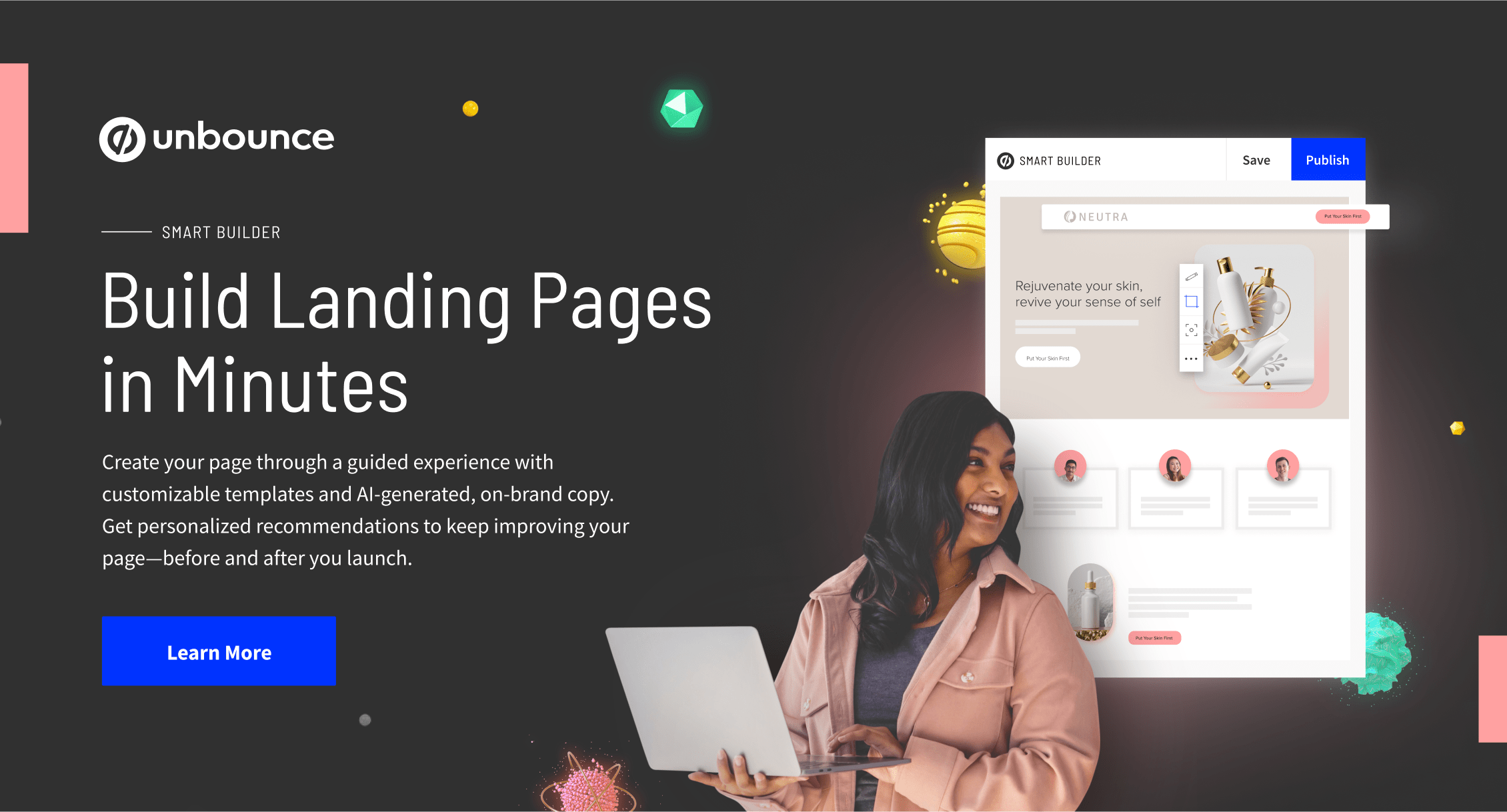The only thing better than the energy of a live event? The excitement you feel before you go.
As an event marketer, your job is to inspire that feeling in potential attendees—and then turn it into action (e.g., ticket sales and registrations).
Whether you’re promoting a conference, show, activity, or even a webinar, the rules are the same: if you can create a certain level of antici—wait for it—pation for an upcoming event, you’re golden.
While building excitement for future events is easier said than done, building an awesome event landing page can help you do just that. With the right message and conversion-focused call to action (CTA), your event landing page can take visitors from “That looks kinda neat” to “I can’t miss out on this!”
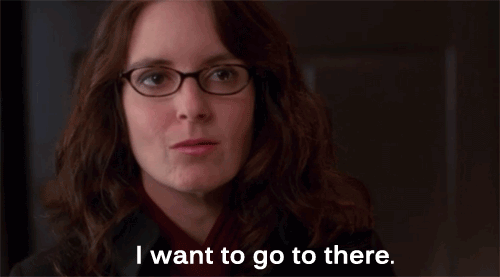
Why do you need event landing pages?
Maybe you’re still wondering, “Should I bother with event landing pages?” The short answer is yes, yes you should (and with the right landing page templates, it’s no bother at all).
Here’s why: Event landing pages are the best way to drive ticket sales and registrations.
There are two main types of event landing pages:
- Event registration landing pages that get visitors to sign up for an event. For free events, registration pages are designed to drive signups and reservations; for paid events, these pages are designed to sell tickets.
- Lead gen landing pages where visitors can ask to receive more details. These pages are designed to build interest and capture contact information (typically an email address so you can contact them closer to the event date or once tickets go on sale, for example).
In either case, an event landing page can support your conversion goal better than a page on your website or a third-party listing. While the latter can easily get bogged down with irrelevant details and competing calls to action, a dedicated event landing page is built to do one thing: convert. Creating one helps you target specific segments and focus on messaging that gets them to RSVP.

How to create an event landing page: Best practices that convert
Simply having event landing pages isn’t enough to guarantee conversions. But if you follow these event landing page design guidelines, you can use your landing pages to make a better first impression and motivate attendees to RSVP.
Here are the main event landing page best practices to keep in mind when designing your own:
Focus on a single conversion goal.
Like all landing pages, pages for your events should be built around one call to action: getting attendees to register. Everything from the headline to the design to the event details provided should support this goal.
Target specific types of attendees.
A major advantage of event landing pages is that you can use multiple variants to target specific types of attendees. For example, if you’re promoting a marketing conference, you might create a unique landing page to target founders specifically.
Give folks something to look forward to.
Your landing page should layer on elements of FOMO and can’t-miss excitement to make visitors itching to attend. Maybe you offer a sneak peek of the upcoming speaker lineup or a fun recap of last year’s event. You could also include quotes from past attendees or photos and video clips of standout moments from a recent show.
Set clear expectations.
Visitors need to know exactly what they’re getting into before they’ll register to attend. It takes a lot to get people out the door, so the best event landing pages highlight all the most important details. Depending on the type of event you’re hosting, your landing page might include an overview of the agenda, speaker details, location, and ticket prices.
Make it easy to RSVP.
For the same reasons you wouldn’t give out confusing directions to your venue, you don’t want your landing page or RSVP form to be confusing. Instead, you should make it as simple as possible for attendees to sign up. Many of the best event landing page designs (including some of the examples below) feature easy-to-complete registration forms.
8 of our favorite event landing page examples built with Unbounce
Looking for a bit of event landing page inspiration? We picked these event page examples because they embody many of the principles described above. We hope you learn a thing or two about event landing page design that you can use to promote your next event.
1. Collective Zoo
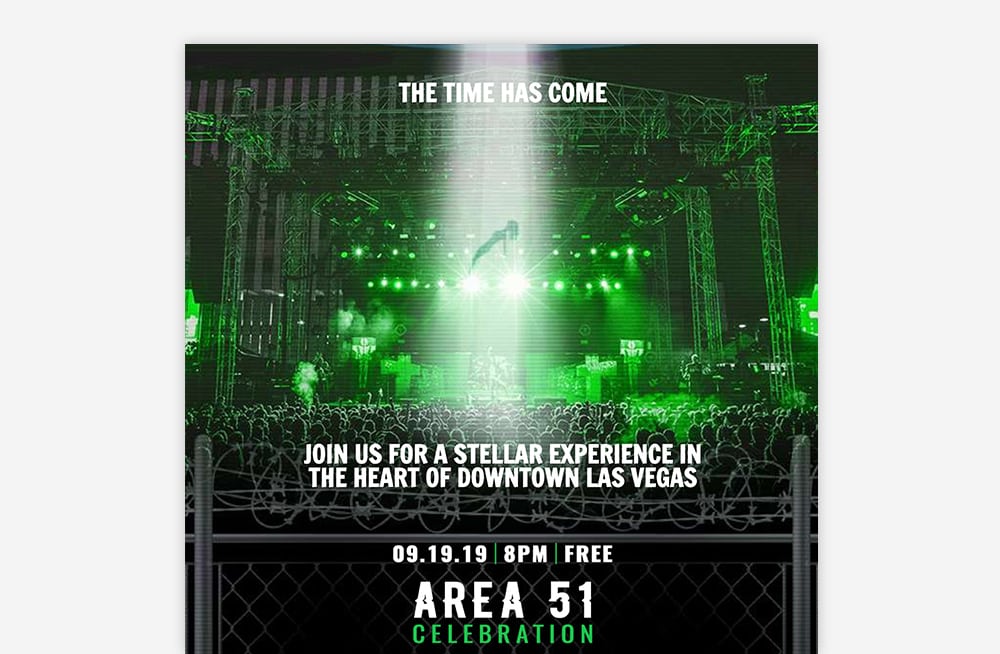
Cerebro Marketing created this page for Collective Zoo to promote a UFO-themed concert. When people from all over America were planning to storm Area 51, this landing page redirected some of that hype to a free event in downtown Las Vegas.
We love that the language is totally on theme (“Discover what to expect below”) and they carry the concept through to the event details with a “classified” lineup. Plus, if you step back to reflect on the overall design, you’ll notice how much this page looks like an actual event poster you might see plastered to a street pole.
The truth (about event landing page design) is out there:
Your event landing page is a preview of your live event. If it’s boring or dull, people will assume your event will be, too. That’s obviously not the case, so it’s important to create an event landing page that sets the right tone. Your landing page copy and landing page design should reflect what your attendees can expect and make it impossible for them to resist signing up.
2. Artist Project Contemporary Art Fair
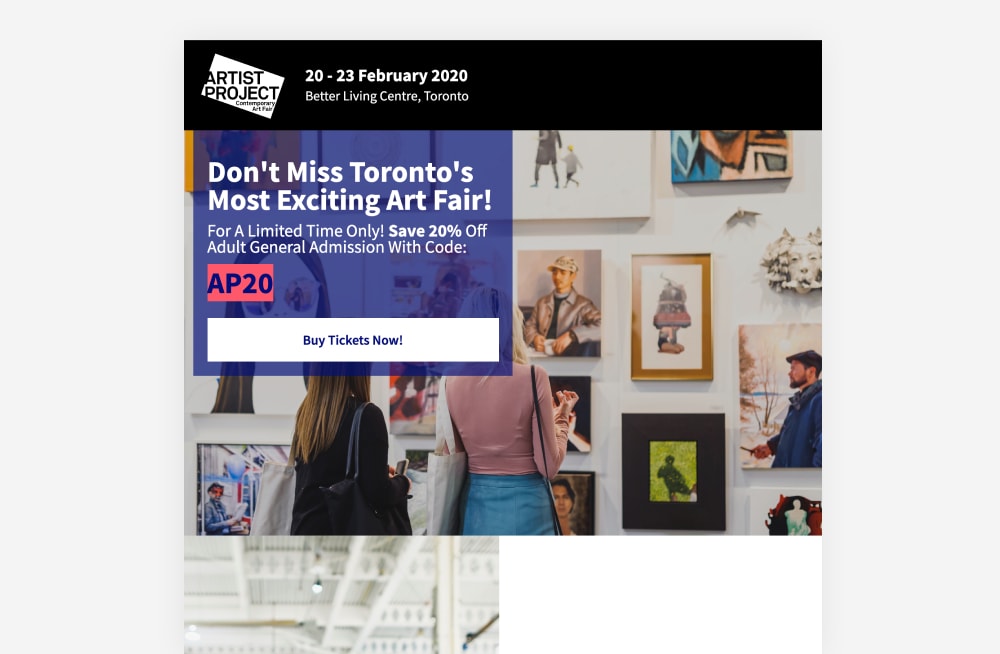
Artist Project launched this event landing page to sell tickets for the Contemporary Art Fair, which ran in February 2020. The page creates a sense of FOMO and urgency to encourage guests to get tickets for the opening night party. With an action-oriented heading “Don’t Miss Toronto’s Most Exciting Art Fair!” and a time-limited offer to save 20%, the message is clear: if you want in on this, take action now.
To drum up interest in an art fair, your design needs to be on point. You can’t promote an art show without, well, showing some art. This landing page does a terrific job showcasing a range of artists and mediums to highlight the diversity featured in the fair. From mixed media reflections on war to vibrant social commentary in the form of collage, it’s clear that a huge variety of art and talent will be in attendance.

In addition to previewing 2020 showcases, we also love that there are featured highlights from previous years. If you’ve been running an event for multiple years, use photos of past excitement to encourage visitors to get in on the fun.
Perhaps the biggest takeaway from this event landing page example is this:
Make a point to weave the heart of your event into your landing page design and copy. Use visuals to tell the story of your event and use CTA-focused copy to turn interest into action.
3. Thinkific
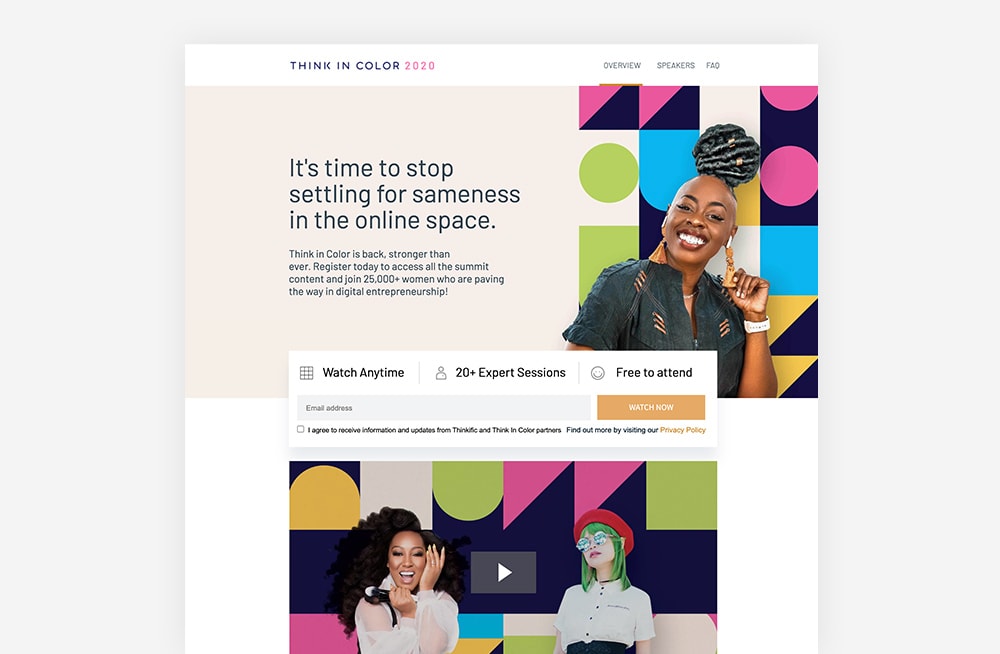
We’ve all heard some variation of the marketing adage: “When you speak to everyone, you speak to no one.” Well, in this example, Thinkific does a great job of speaking to one specific demographic: women entrepreneurs in the digital space. More importantly, Thinkific highlights how the free virtual summit, Think in Color 2020, caters to this particular audience.
The images and video are particularly powerful because they show attendees that the speakers are diverse, young, intelligent women who are excited to share their industry knowledge and lift other women up.
Combined with inclusive messaging (“stop settling for sameness in the online space”) and an emphasis on the unique challenges that women face in building an online business, this landing page gives attendees plenty of incentive to get in on the action.
Here’s an important reminder from this example:
When designing a registration form, for example, remember that less is often more. Remove potential barriers by keeping forms short and sweet. Only ask for the essential details needed to get attendees on the list and make sharing additional info optional.
4. Netwrking.com
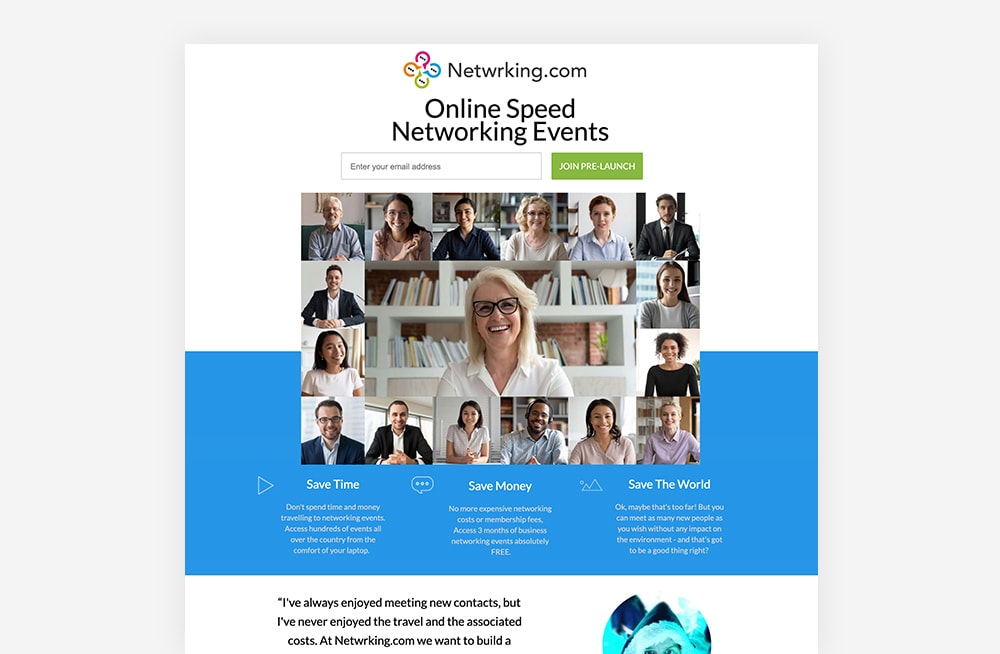
You’ve heard of speed dating, but what about speed networking? Netwrking.com hosts online speed networking events and created this event landing page to build a pre-launch list.
This approach makes sense for the target audience—since the idea of getting in on the ground floor appeals to those interested in making new business connections—but it can also work for other types of highly-anticipated live events.
We love that the landing page hero image makes it feel like you’re already on a video call with your new group of contacts. They use language that speaks to entrepreneurs and optimists (“You’ve got to have a dream, right?”) and invites the reader to participate (“We’d like to have thousands of members on board before the end of 2020 and we need you to join us today!”). Plus, the only piece of information required to sign up is your email address.
What you can take away from this event landing page example:
Any type of pre-event registration like this will help you identify your most ideal customers. And since the goal is to drive interest, rather than get people to commit to making a purchase, this type of registration page can be launched far in advance.
5. Paint Cabin
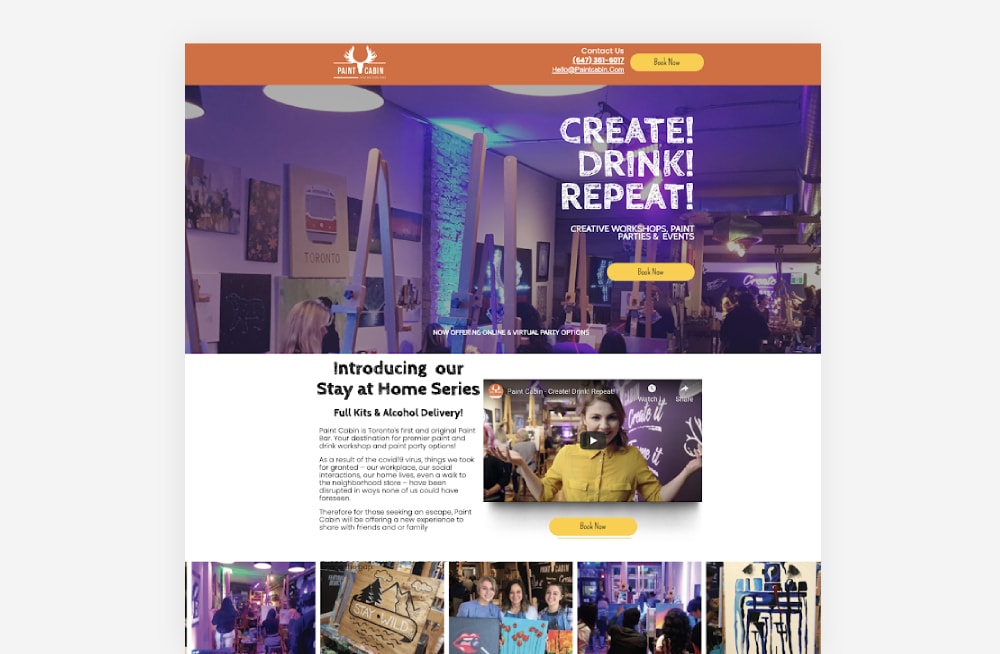
Created by agency Disruptive Advertising, this event landing page focuses on Paint Cabin’s virtual paint nights. The concept of this event is simple yet innovative: You can attend a live paint night from the comfort of your own home. This might sound counterintuitive at first, but the landing page fills in all the blanks before you have a chance to ask, “How does that work?”
We love the energetic headline and color contrast. “Create! Drink! Repeat!” is both descriptive and fun, and paints a clear picture of what the event is all about. The design is engaging in the way a paint night should be.
Plus, the content plays into attendees’ sense of FOMO, urging them not to “miss a thing” by “book[ing] now.” By adapting to offer private streaming as part of this “stay at home series,” Paint Cabin creates a hybrid live-virtual event to fit the times—and this example gives guests hope that they can enjoy a favorite activity while still social distancing.
Here’s the biggest lesson we hope you learn from this example:
Video content is always a great addition to your landing pages. Whether it’s a montage of clips from past events, a recap of last year’s convention, or a promotional video for an upcoming headliner, videos make a huge impact without taking up a ton of space on your page. Use videos to help returning guests relive the magic and give first-timers a sneak peek of what’s to come.
Editor’s note (if you’re reading this in 2022 and beyond): Although adding video was considered best practice a couple years ago, recent data shows that video on landing pages doesn’t have a huge impact on conversions. In some cases, it may even make people bounce. Yikes!
6. FraudBuzz
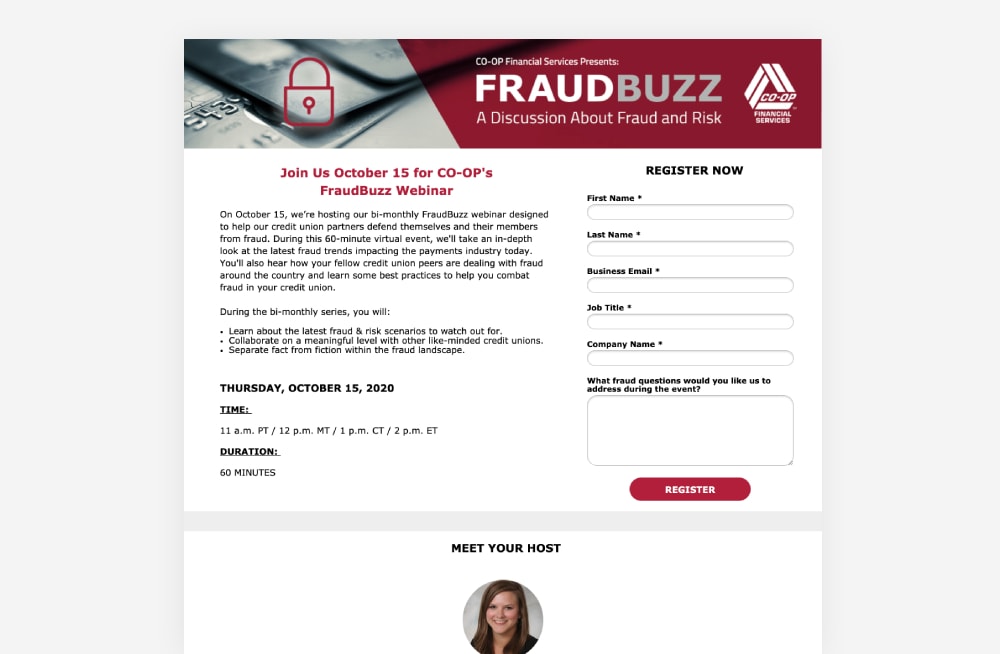
At first glance, this page comes across as fairly simple (especially in comparison to the last few examples listed above). But that’s not a bad thing. On the contrary, the clean, no-frills design sets just the right tone for the topic at hand: fraud protection and prevention.
Co-Op Financial Services created this landing page to drive registrations for its monthly webinar series, FraudBuzz. It’s short and concise, but also informative enough to do the trick.
In fact, it answers just about every question attendees might have before signing up, including:
- Who? “Meet your host”
- What is it? A live webinar discussion about fraud and risk.
- Where and when? Presented online, with the date, time, and duration listed.
- Why? “During the bi-monthly series, you will learn about…”
- How to attend? Fill out the form, which is conveniently visible above the fold.
What other event marketers can learn from this example:
Your event landing page doesn’t need to be long to be helpful, and it doesn’t need to be flashy to get your message across. By providing key details and the right amount of context for whatever event you’re hosting—whether that’s a quick overview or an in-depth agenda—you can ensure your page appeals to the right type of attendees.
7. Shoelace
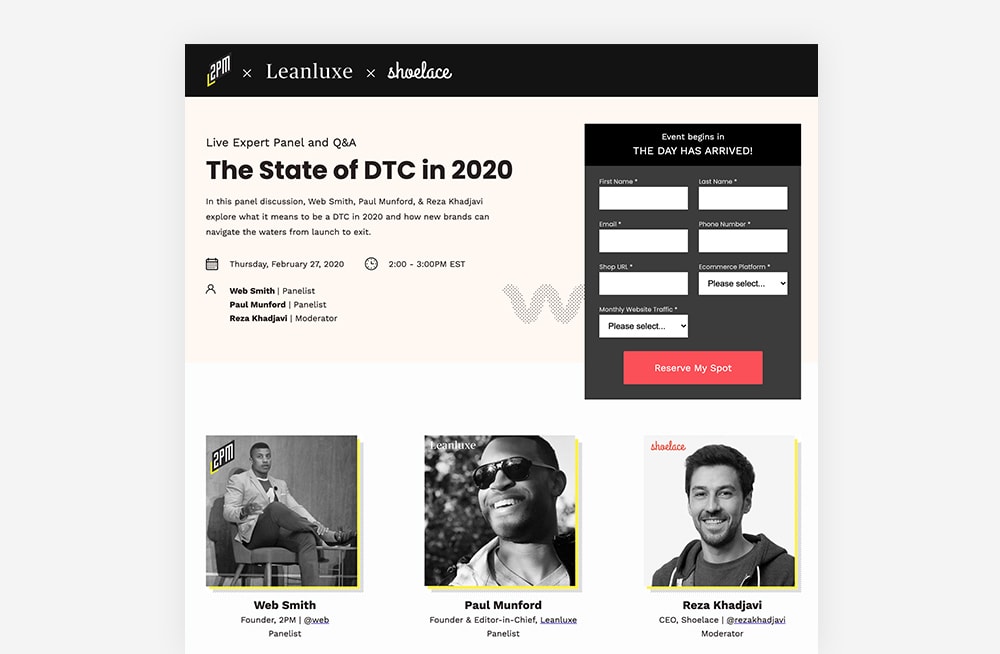
The retargeting pros over at Shoelace built this event landing page for a webinar hosted earlier this year. They knocked it out of the park by telling attendees exactly what to expect—including who, what, where, when, and how to sign up.
First off, the heading and introductory blurb provide valuable context about the topic itself. Next, core details about the event, like the date, time, and duration, are laid out; and the panel members are listed.
And that’s all happening above the fold.
As we scroll down the page, we’re greeted with images of the panelists and moderator, along with their titles and companies. For those who dig deeper for more info, Shoelace delivers punchy, informative bullet points that elaborate on the topics being discussed.
Here’s your key takeaway from Shoelace:
Use your event landing pages to highlight some of the value attendees get from your event. If the main event is your speakers’ expertise, for example, make a point of introducing who they are and what they do. As we can see in the example above, including panelists’ pictures, titles, and companies is a good place to start.
8. Twinwoods Adventure
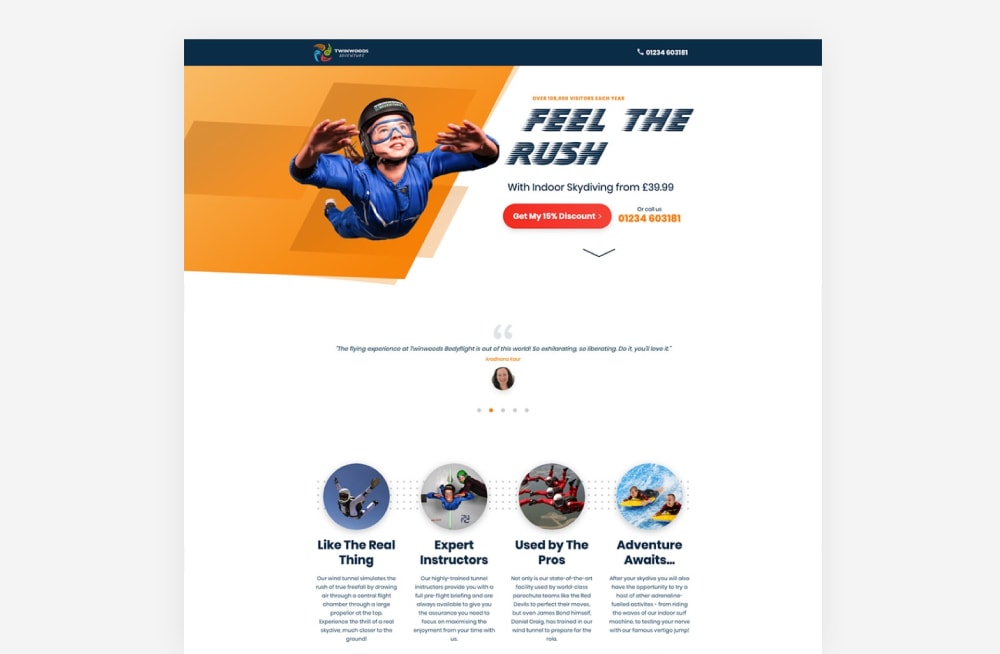
This use case is a bit different than our other event landing pages examples. Twinwoods Adventure uses this landing page to drive bookings for indoor skydiving. Although this isn’t a one-off, pre-scheduled event, the goal is still to get booking and sell tickets in advance.
One of the best things about this page is that it’s immediately obvious what the activity is, thanks to heavy-hitting visuals balanced with information copy. The price is listed upfront for transparency, followed closely by a CTA with a clearly defined value (“Get My 15% Discount”).
On the live page, that’s an animated hero—which really brings the headline (“Feel the Rush”) to life. Further down the page, there’s also a video that shows the wind tunnel in action. This ticks a whole buncha boxes: Setting attendee expectations, showcasing the activity, and creating excitement.
Plus, they play off FOMO in a big way by:
- Boasting that they “attract over 100,000 visitors per year”
- Showing off their high ratings on Google, Facebook, and TripAdvisor
- Including quotes from real visitors (“Do it, you’ll love it.”)
Here’s a design tip you can borrow from this example:
Twinwoods knows people might want to learn more about the experience before booking. So, they used on-page tabs to answer FAQs. Because this loads the information directly on the landing page, there’s no reason for interested customers to click away before booking.
Turn anticipation into action with event landing pages
We know how difficult and time-consuming it is to create event landing pages from scratch. If you hire outside devs to do the job, you might spend more than you’d like. Worse, building an event landing page from the ground up takes ages—and can prevent you from running campaigns with enough lead time before your event.
Thankfully, Unbounce’s Smart Builder makes it easier to start promoting your event and accepting RSVPs. There’s never been a faster way to create beautiful, conversion-centric event landing pages that get folks excited to attend.
